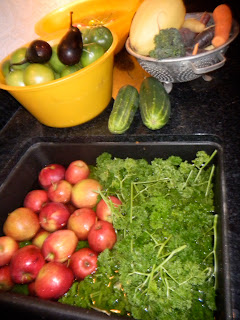Entering the house on frosty days like these, there's nothing like the assault of fresh bread on the nose. This is the best bread recipe I have- its flavour coveted by many. And it comes care of a lady who babysat me on weekends my parents stole away. Grandma Blair is not my grandmother and probably not yours, but when you taste this bread you'll realize its how you imagine family to be. A little crusty on the edges, warm and soft on the inside, with many different kinds of seeds giving variety to each bite.
As with all my bread recipes, I've cut out most of the traditional steps of punching down and waiting forever to bake it. If you are a real stickler, then follow the traditional bread methods with this dough. But if you are like me, lazy and impatient with delayed gratification, then feel free to cut corners with any of your recipes too. This is how I approach any and all bread recipes:
1. Put all the dry ingredients in bowl. Mix.
2. Put all the wet ingredients in.
3. Mix. Add extra flour if dough is too wet (though don't be deceived when using a mixer- the more whole wheat you use, the less likely the dough will gather in a ball on the hook!). If you are mixing by hand, this is where the dough will become too stiff to stir, so you will knead it with your hands. Depending on what you are making, the finished dough will have different texture: Bread and buns dough will be soft and wet, keeping its form but just barely. Pita, pizza and bagel dough will be stiffer- they use less liquid and more flour.
4. Leave dough to 'rest' for five minutes in mixing bowl.
5. Decide: Cook it now or later? Most recipes make two loaves, so you may want to only cook one loaf and save the other dough for later.
6. TO COOK IT LATER: Place dough in a large bag/ container and place in the fridge (you can let it rise on the counter for up to 2 hours). This dough will keep in the fridge for up to two weeks, and the longer it 'cold rises' the more complex the flavour.
5. TO COOK IT NOW: Shape into forms- loaves, buns, twists, braids.
6. Let shaped dough rise for an hour on the counter (cover if you want). Experiment with the rise time, you may not notice the difference between an hour rise and a half-hour in the finished product. If I'm in a hurry, I may form dough into buns and leave them only a half hour to rise - they then cook fast and are done within the hour. Dough will rise another quarter its size as it cooks.
7. TO USE DOUGH FROM THE FRIDGE: The cold rise experts say to remove dough from fridge and allow it to warm to room temperature before forming it. However, I form the dough immediately after removing it with no problems. In the case of cinnamon twists (a post for next week), I will often remove the dough, shape it, and put it straight in the oven. We're eating twists 20 minutes after removing the dough from the fridge.
8. So, forget the rules and experiment! For more on this, check out this past post on the basic bread recipe.
Grandma Blair Bread
Finally, the recipe... it can be made in the mixer or is small enough to easily mix by hand. Makes 2 loaves or 2 dozen buns.
1. Mix dry ingredients in a bowl:
- 1/2 C Red River Cereal
- 1/4 C each: Sunflower, poppy, flax seeds and millet
- 1 T Yeast
- 1 t Salt
- 3 C White Flour
- 3 C Brown Flour
- 1/4 Brown Sugar
2. Add wet ingredients to dry ingredients:
- 1/8 C molasses (or more to taste)
- 1 egg, beaten
- 1/4 C oil
- 2 3/4 C warm water
3. Mix/knead until dough is soft and pliable (elastic is how it feels, but its hard to explain until you feel it!). Add flour if necessary.
4. Let rest five minutes.
5. Form into bread or buns and let rise another hour OR place in bag for 'cold rise' in the fridge for up to two weeks.
6. Cook at 375 F. Bread for 45 minutes, Buns for 20-25.
7. Slice, eat and enjoy.


















































